
The Sahara is a desert on the African continent. With an area of 9,200,000 square kilometres (3,600,000 sq mi), it is the largest hot desert in the world and the third largest desert overall, smaller only than the deserts of Antarctica and the northern Arctic.

Carcharodontosaurus is a genus of large carcharodontosaurid theropod dinosaur that existed during the Cenomanian age of the Early Cretaceous in Northern Africa. It is currently known to include two species: C. saharicus and C. iguidensis, which are among the largest theropods, nearly as large as or even larger than Tyrannosaurus, Giganotosaurus, and Spinosaurus.
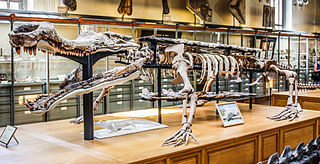
Sarcosuchus is an extinct genus of crocodyliform and distant relative of living crocodylians that lived during the Early Cretaceous, from the late Hauterivian to the early Albian, 133 to 112 million years ago of what is now Africa and South America. It was one of the largest crocodile-line reptiles, reaching an average estimate of 9 m (30 ft) and 3.5 metric tons, but estimated to grow up to 9.5 m (31 ft) in body length and weigh up to 4.3 metric tons. It is known from two species, S. imperator from the early Albian Elrhaz Formation of Niger and S. hartti from the Late Hauterivian of northeastern Brazil, other material is known from Morocco and Tunisia and possibly Libya and Mali.

Suchomimus is a genus of spinosaurid dinosaur that lived between 125 and 112 million years ago in what is now Niger, during the Aptian to early Albian stages of the Early Cretaceous period. The animal was named and described by palaeontologist Paul Sereno and colleagues in 1998, based on a partial skeleton from the Elrhaz Formation. Suchomimus's long and shallow skull, similar to that of a crocodile, earns it its generic name, while the specific name Suchomimus tenerensis alludes to the locality of its first remains, the Ténéré Desert.
Jobaria is a genus of sauropod dinosaur that lived in what is now Niger during the middle Jurassic Period, between 164 and 161 million years ago. Jobaria is currently the only known valid sauropod from the Tiouraren, where it was discovered in 1997.

Afrovenator is a genus of megalosaurid theropod dinosaur from the Middle Jurassic Period of northern Africa.

Rugops is a genus of abelisaurid theropod dinosaur that inhabited what is now Africa approximately 95 million years ago, during the Cenomanian stage of the Late Cretaceous.
Jeffrey A. Wilson, also known as JAW, is a paleontologist and professor of geological sciences and assistant curator at the Museum of Paleontology at the University of Michigan.
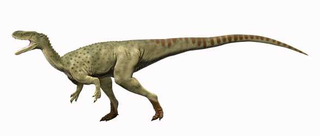
Spinostropheus is a genus of carnivorous ceratosaurian theropod dinosaur that lived in the Middle Jurassic period and has been found in the Tiouraren Formation, Niger. The type and only species is S. gautieri.
Dong Zhiming is a Chinese vertebrate paleontologist formerly employed at the Institute of Vertebrate Paleontology and Paleoanthropology (IVPP) in Beijing. He began working at the IVPP in 1962, studying under Yang Zhongjian, who was director at the time. He has described fossil remains of many dinosaurs. He investigated and described the Shaximiao Formation; an important contribution to science since they are composed of Middle Jurassic beds which do not commonly yield fossils.
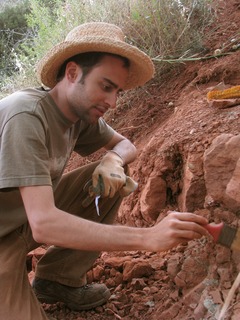
Stephen Louis Brusatte is an American paleontologist and evolutionary biologist, who specializes in the anatomy and evolution of dinosaurs. He was educated at the University of Chicago for his BS degree, at the University of Bristol for his MSc on a Marshall Scholarship, and finally at the Columbia University for MPhil and PhD. He is currently a Reader in Vertebrate Palaeontology at the University of Edinburgh. In addition to his scientific papers and technical monographs, his popular book Dinosaurs (2008) and the textbook Dinosaur Paleobiology (2012) earned him accolades, and he became the resident palaeontologist and scientific consultant for the BBC Earth and 20th Century Fox's 2013 film Walking With Dinosaurs, which is followed by his popular book Walking with Dinosaurs Encyclopedia. His most recent book The Rise and Fall of the Dinosaurs: A New History of a Lost World (2018), written for the adult lay person, won widespread acclaim, and was a New York Times bestseller.

Kryptops is a genus of abelisaurid theropod dinosaur from the Early Cretaceous of Niger. It is known from a partial skeleton found at the Gadoufaoua locality in the western Ténéré Desert, in rocks of the Aptian-Albian age Elrhaz Formation. This dinosaur was described by paleontologists Paul Sereno and Stephen Brusatte in 2008. The genus name means "covered face", in reference to evidence that the face bore a tightly adhering covering. The type species is K. palaios, which means "old".
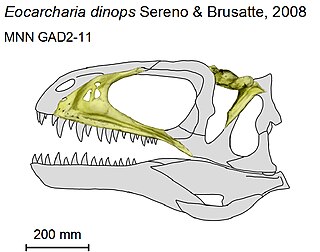
Eocarcharia is a genus of carcharodontosaurid theropod dinosaur from the Early Cretaceous Elrhaz Formation that lived in the Sahara 112 million years ago, in what today is the country of Niger. It was discovered in 2000 on an expedition led by University of Chicago paleontologist Paul Sereno. The type and only species is Eocarcharia dinops. Its teeth were shaped like blades and were used for disabling live prey and ripping apart body parts. Eocarcharia’s brow is swollen into a massive band of bone, giving it a menacing glare. It may have reached lengths of 6–8 m (19.7–26.2 ft).
The Kiffian culture is a prehistoric industry, or domain, that existed between approximately 8,000 BC and 6,000 BC in the Sahara Desert, during the African humid period referred to as the Neolithic Subpluvial. Human remains from this culture were found in 2000 AD at a site known as Gobero, located in Niger in the Ténéré Desert. The site is known as the largest and earliest burial place of Stone Age people in the Sahara desert.
The Tenerian culture is a prehistoric industry that existed between the 5th millennium BC and mid-3rd millennium BC in the Sahara Desert. This spans the Neolithic Subpluvial and later desiccation, during the middle Holocene.
The Tiourarén Formation is a geological formation in the Agadez Region of Niger whose strata were originally thought to be Early Cretaceous. However, re-interpretation of the sediments showed that they are probably Middle Jurassic (Bathonian) in age. It is the uppermost unit of the Irhazer Group. Dinosaur remains are among the fossils that have been recovered from the formation.

Nigersaurus is a genus of rebbachisaurid sauropod dinosaur that lived during the middle Cretaceous period, about 115 to 105 million years ago. It was discovered in the Elrhaz Formation in an area called Gadoufaoua, in the Republic of Niger. Fossils of this dinosaur were first described in 1976, but it was only named Nigersaurus taqueti in 1999, after further and more complete remains were found and described. The genus name means "Niger reptile", and the specific name honours the palaeontologist Philippe Taquet, who discovered the first remains.
The Gobero archaeological site, dating to approximately 8000 BCE, is the oldest known graveyard in the Sahara Desert. The site contains important information for archaeologists on how early humans adapted to a constantly changing environment. Gobero is located in the Ténéré desert of Niger, and is named after the Tuareg name for the region. It is the type site of the Holocene era Kiffian culture and Tenerian culture.
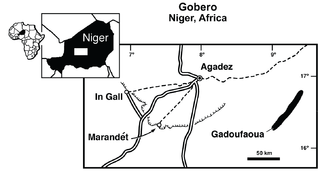
The Elrhaz Formation is a geological formation in Niger, central Africa.

Nizar Ibrahim is a German-Moroccan vertebrate paleontologist and comparative anatomist. He is currently a senior lecturer at the University of Portsmouth. Ibrahim has led several expeditions to Africa's Sahara and is notable for his research on fossil vertebrates from the Kem Kem Group, including pterosaurs, crocodyliforms, and dinosaurs. In recent years, research led by Ibrahim radically changed ideas about the morphology and life habits of one of the largest predatory dinosaurs, Spinosaurus aegyptiacus. Ibrahim also has interests in bioinformatics and contributed to the NSF-funded Phenoscape project. He regularly engages with the public and is a speaker with the National Geographic Speakers Bureau.















